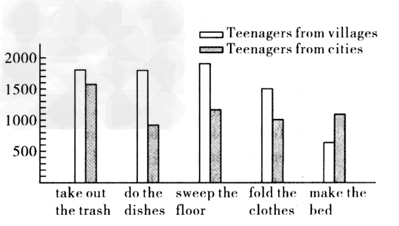阅读理解。

Do teenagers in small villages do chores at home? How about the teenagers in big cities?
Here is a survey. We asked 4,000 teenagers in China several questions. Half of them come from big
cities like Beijing, Shanghai and Guangzhou.The others are from small villages. We made a diagram of the
result of our survey. Let's have a look at it.
We found out that teenagers from small villages do more chores than those from big cities. Maybe it
is because they live a harder life.Our advice to parents in big cities is that parents should give their children some chores to do. Doing chores teaches teenagers to take care of themselves.
1. They surveyed ______ teenagers from small villages.
A. 1,000
B. 2,000
C. 4,000
D. 3,000
2.There are l,000 teenagers from the cities who______.
A. take out the trash
B.do the dishes
C. make the bed
D.fold the clothes
3. Fewer than______teenagers in big cities sweep the floor and make the bed.
A. 500
B.1,000
C.1,500
D.2,000
4. The number of teenagers______in big cities is bigger than that in small villages.
A. making the bed
B.taking out the trash
C. folding the clothes
D.doing the dishes
5. Why did they make the survey?
A. Because they don't want teenagers in China to do chores at home.
B. Because they thought it'Il help teenagers to take good care of themselves to do chores at home.
C. Because they wanted to know if teenagers in China do chores at home.
D. Because they thought it's not necessary for teenagers to look after themselves.